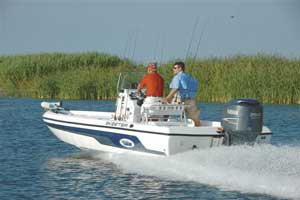
After Katrina and Rita, experts predicted several lean duck years, but the habitat has rebounded remarkably well, and this season may be one for the ages.
A reduction in your boat’s cruising speed while your engine is turning its usual number of revolutions can indicate problems. Crud growing on the hull, a leak allowing water to collect in the hull and propeller damage can all cause a speed reduction and waste today’s high-priced fuel. Performance-minded boaters looking for ways to squeeze another mile per hour out of their rigs track their speed to determine how well each change or adjustment works. Fishermen who troll are at the other end of the speed spectrum, where accurate speed measurement can mean the difference between fish in the box or just a boat ride.
Uncalibrated conventional speedometers that use pitot tubes or water pickups built into an engine’s lower unit to sense speed are sometimes only accurate within about 30 percent. Calibrated speedometers are accurate but usually don’t work at slow trolling speeds.
Electronic measurement methods can be more accurate across the whole speed spectrum. In-dash, GPS-based speedometers are now available, and bracket-mounted GPS mapping units, fish finder/GPS combo units and inexpensive handheld GPS units using DGPS or WAAS corrections should all deliver speed readings within a fraction of a mile per hour of a radar gun.
State of the Art?
Almost every GPS unit made today offers the extra accuracy of WAAS, but having WAAS capability doesn’t guarantee WAAS accuracy. WAAS position corrections come from satellites low on the southern horizon, and if a hill, bridge or standing fisherman is between your GPS antenna and those satellites, you get only standard GPS information from the satellites overhead and speed readings may lose a bit of accuracy.
Most units have a built-in alarm that warns you when corrections are not being received, but if the factory default setting for them is “off,” you have to go into the unit’s menu and turn them on.
Consistency is more important than absolute accuracy when trolling. If you catch fish at an indicated speed of 2.5 m.p.h. and catch nothing when it reads faster or slower, it doesn’t matter if you are going exactly 2.5 m.p.h., you just need to be able to return to the exact same speed after landing each fish.
Paddle Wheels
Paddlewheel speed sensors available for most fish finders come built into transom-mounted transducers or designed to mount separately on the transom. They can provide a more-consistent speed reading, especially at slow speeds, than GPS in areas where WAAS or DGPS corrections are not available.
Paddlewheels measure the speed of your boat in relation to the surface of the water, and when that water is moving they are generally more accurate than GPS. River current and tidal flows are obvious water movers, but wind can also move surface water like a skin-deep current on top of a lake.
If your boat’s top speed is 50 m.p.h. and you are running in the same direction as a 4 m.p.h. current, GPS will show your speed at 54 mph because its “speed over ground” reading measures your rate of travel over the surface of the earth. If your boat is running against the same current, GPS will show its speed to be 46 mph.
Paddlewheel sensors are not always accurate above 50-55 m.p.h. Most boat hulls tend to drag a bit of surface water with them at high speed, and that can fool the sensor. A paddlewheel mounted too deep in the water might read a bit slow at planed boat speeds, while one mounted too shallow could read a bit fast.
Mounting a paddlewheel on the transom correctly is just as critical to speedometer performance as mounting a sonar transducer is to fish-finder performance. The manufacturer’s instructions should be followed to the letter in both cases.
The Bottom Line
Measuring boat speed is hardly rocket science, but doing it accurately requires a bit of thought. GPS speed over ground measurements are probably the best way to track high speeds, and paddlewheel sensors are often best for tracking trolling speeds, although some GPS units do it very well with the help of DGPS or WAAS corrections.
In any case, remember that consistency can be more important than raw accuracy for spotting boat problems and for catching fish.


